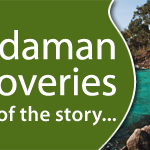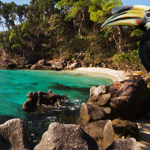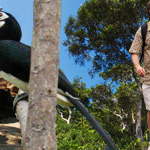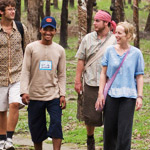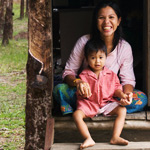Andaman Discoveries Blog
Tuesday, June 16, 2009
Erik’s Adventures - Fragile Footing
Can Ecotourism Save the Ban Naa River?
 P’ Lek stares wistfully at the banks of the Ban Naa River, located about 65 kilometers south of Ranong, while he pilots our inflatable raft downstream. On our left is a large concrete tower -- formerly part of a suspension footbridge -- now toppled and half-submerged, enmeshed in a tangle of cables. The surrounding land has all been cleared, stripping its rebar-like root system; recent monsoon rains swept away the tower’s vulnerable footing. Across the river a lone tower stands sentinel amongst dense forest.
P’ Lek stares wistfully at the banks of the Ban Naa River, located about 65 kilometers south of Ranong, while he pilots our inflatable raft downstream. On our left is a large concrete tower -- formerly part of a suspension footbridge -- now toppled and half-submerged, enmeshed in a tangle of cables. The surrounding land has all been cleared, stripping its rebar-like root system; recent monsoon rains swept away the tower’s vulnerable footing. Across the river a lone tower stands sentinel amongst dense forest.Further downstream we anchor at an oxbow where rubber tree saplings cling dearly to the abrupt precipice; this year alone the river’s dimensions at this location have swelled by several meters through erosion. Lek and his team of five villagers set about measuring the damage -- river width and depth -- using rope, a plumb, a tape measure, a length of blue PVC pipe, and a camera. I’m one of several Westerners who have joined them on this rainy day -- including staff from Andaman Discoveries, N-ACT, and the Peace Corps -- to survey roughly three kilometers of the Ban Naa River and assess its eco-tourism potential.
 A few years ago this muddy, silted beach was lined with a protective canopy of native jungle, with an accompanying chorus of high-pitched locusts and birdsong. And as many years ago the mono-crop plantations of rubber and oil palm that now conspicuously abut upon the river were home to varied fruit orchards. A recent drop in fruit prices encouraged the switch from these crops. “I love this area and want to see it restored. I am hoping to use tourism as a tool to re-introduce sustainable agriculture to the area,” Lek told us.
A few years ago this muddy, silted beach was lined with a protective canopy of native jungle, with an accompanying chorus of high-pitched locusts and birdsong. And as many years ago the mono-crop plantations of rubber and oil palm that now conspicuously abut upon the river were home to varied fruit orchards. A recent drop in fruit prices encouraged the switch from these crops. “I love this area and want to see it restored. I am hoping to use tourism as a tool to re-introduce sustainable agriculture to the area,” Lek told us.The nickname Lek, which is the Thai word for small, is as incongruous on this imposing forty-something man with a wispy ponytail as his 4X4 racing t-shirt is to his ethos of conservation. His vision is to staunch the degradation of this area and eventually reverse it by reintroducing the cultivation of sustainable mixed agriculture through community-based ecotourism. With tourists paying to harvest fruit, he hopes to make this type of farming financially viable again. In addition, he’s launching youth conservation efforts to educate young people as to the value of conservation.
 At the next stop Lek harvests a few krai nam saplings. These trees have robust root structures, and Lek will re-plant them upstream in areas where the shoreline has been compromised by erosion. By relocating them upstream he also hopes that their seeds will eventually find purchase in soil further down. Such ideas are in stark contrast to the solutions employed by the mono-crop farmers, as I soon learned firsthand. At another stop, we anchor the raft along a desolate shore of dirt and stones. I jumped out of the raft and thought ground had been pulled out from under me – here the river had been dredged with a backhoe, forming a deep channel right up to the shore. This practice requires continual maintenance, and drastically increases silting problems downstream.
At the next stop Lek harvests a few krai nam saplings. These trees have robust root structures, and Lek will re-plant them upstream in areas where the shoreline has been compromised by erosion. By relocating them upstream he also hopes that their seeds will eventually find purchase in soil further down. Such ideas are in stark contrast to the solutions employed by the mono-crop farmers, as I soon learned firsthand. At another stop, we anchor the raft along a desolate shore of dirt and stones. I jumped out of the raft and thought ground had been pulled out from under me – here the river had been dredged with a backhoe, forming a deep channel right up to the shore. This practice requires continual maintenance, and drastically increases silting problems downstream.To be sure, Lek and his team face an uphill battle. There are powerful, well-financed forces at work in the area whose only concern is quick profits. But the optimism of Lek and his staff is contagious, and combined with the natural beauty of the area one cannot help but feel inspired by his team’s grassroots efforts.
In addition to the rafting trip, the area offers attractive ecotourism opportunities such as a short hike to a hot/cold spring and an overnight hike to the La Ong Dao waterfall. The village of Ban Naa also offers visitors the opportunity to engage with the monks of a forest temple and the chance to learn from local artisans whose handicrafts include weaving and making rattan furniture.
For more information about Ban Naa, please contact Nat at info@andamancommunitytourism.com
Labels: agriculture, conservation, ecotourism, erosion, mono crop, rafting, sustainability
Subscribe to Comments [Atom]

